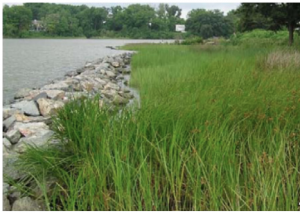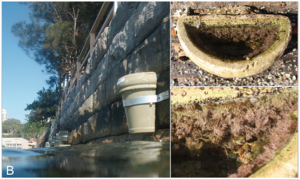Human coastal populations are steadily increasing and make up over 70% of the world’s population, yet are increasingly vulnerable to the threat of climate change induced extreme weather events and sea-level rise. The Intergovernmental Panel on Climate Change predicts a worst-case sea level rise of 0.59m by 2100, but new studies suggest this value may be exceeded in half the time. Regardless of the predicted values, the future effects of climate change on coastal areas will be seen through fisheries and marine habitats, local economies, water resources, increased frequency and intensity of storm events, increased coastal erosion, and increased flood risk. It is imperative to mitigate the effects of climate change where possible by building resilience into coastal communities, including employing strategies for shoreline protection and flood prevention [1]. Increased resilience provides the ability to adapt to change and recover from disruptions from an economic, environmental, and social perspective [2].
Traditional coastal engineering strategies approach the issue of coastal protection with hard, engineered structures to disrupt sediment transport and mitigate flooding. While these built structures may protect the shoreline, they may also have unintended consequences such as the destruction of natural habitat, proximate erosion, and biodiversity alterations and loss [1]. These unintended consequences provide the opportunity for alternate solutions to coastal protection which are sustainable, reliable, and cost-effective while addressing the threat of accelerated sea level rise due to climate change and the minimization of the effects of hard engineered structures on local ecosystems [3].
In this blog, green infrastructure refers to “natural and semi-natural areas with other environmental features designed and managed to deliver a wide range of ecosystem services” [4]. Ecosystem services refers to the benefits humans gain from healthy ecosystems. The integration of green infrastructure in coastal protection can offer shoreline erosion mitigation and foster healthy ecosystems, which provide ecosystem services.
Effective Strategies
An effective strategy to implement green infrastructure into coastal engineering is the development of a hybrid approach to coastal protection. A hybrid approach applies systems-thinking to integrate both hard engineering and green infrastructures and addresses each options strengths, challenges, and effects. Hybrid engineering structures address the limited capacity of natural ecosystems during extreme events and the economic and social costs of hard engineering. As the depth of knowledge on in the interaction between hard engineering and green infrastructure increases, the opportunities for innovative hybrid solutions will increase [2].
Building Materials and Design Considerations
The integration of natural materials in the design of coastal protection can include “sand, sand-fill, wetland plants, oyster reefs, aquatic vegetation, stones, and coir fiber logs” [2]. Using a combined approach of coastal engineering and ecosystem engineering allows for the use of local ecological species to compliment engineering solutions to achieve coastal resilience. For example, oyster beds, mussel beds, willow floodplains, and marram grass can be used to trap sediment and attenuate waves [3]. Simultaneously, hard engineering structures can be designed to better meet the needs of local ecological species and enhance ecosystem functioning by providing a more suitable habitat [2] [3]. Another example of a hybrid approach is the adaptation of dikes and dams to enhance ecological habitat, ecosystem functioning, and sediment precipitation [2] [3]. Further, the construction of artificial structures to support the restoration of shellfish reefs or coral reefs can build coastal resilience by providing ecosystem services of wave attenuation and erosion mitigation [2].

Source: National Park Service, Coastal Adaptation Strategies Handbook.
Interdisciplinary Communication
A key component of effective design of hybrid systems is interdisciplinary communication between involved parties, including engineers, ecologists, First Nation communities with traditional local knowledge, and project stakeholders.
Precautions
There is no universal solution for improving coastal resilience as all shorelines are unique, so many different design strategies must be considered to improve coastal resilience. Since very little data is available, the observation of previous studies and projects is important to learn which approaches are most successful in different locations and circumstances. It is widely understood that more research is needed to further develop strategies for building coastal resilience into future hybrid projects [2].
Research must be done to determine the efficacy and unintended consequences of designs, including the effects of the construction of the design. Likewise, it’s important to ensure the effects of the solution have been considered on a temporal and spacial scale, meaning the unintended consequences of the design have been considered in the long term and also for nearby ecosystems [1].
Implementation, Policy, and Tools
As more information is gained, developments can be made in policies, zoning, design codes, and decision and planning tools [2]. Strategies to integrate green infrastructure into coastal engineering design include “building the case for natural coastal protection” and bringing green infrastructure “into the mainstream decision process” [6].
By improving research and building better models which account of combined risks, a clearer understanding of the magnitude of coastal protection from green infrastructure can be used to make decisions. Likewise, the valuation of ecosystem services from green infrastructure can inform economic arguments for decision makers. The development of policies, planning tools, and decision-support tools which consider the benefits of green infrastructure will bring hybrid approaches to coastal engineering into the mainstream development planning process [6].
Challenges of Hybrid Designs
The major challenge associated with the application of hybrid designs to coastal engineering is the lack of data, testing, and design practices. Due to the unique nature of coastlines, there is no clear design code or even best practice guideline to inform which solutions may be best in a situation [3]. Further, hybrid designs do not provide the same degree of ecosystem services as strictly green infrastructure applications may provide, and may still produce negative impacts on local ecology. Also, since the hybrid projects are relatively new, the permitting process may be more difficult than for traditional, established infrastructure projects.
The existing data that is available suggests the application of solely green infrastructure is best for low energy shorelines [6]. In situations where engineering criteria, local site conditions, or hydro-dynamic conditions necessitate the use of strictly hard engineering solutions, small ecological considerations can be applied to the design such as modified structures which enhance biodiversity habitats. While the solution may be small, the consideration of local biodiversity may mitigate the ecological impact of habitat destruction during construction and aid with community acceptance and permitting [3].

Source: M. Browne and M. Chapman Ecologically Informed Engineering Reduces Loss of Intertidal Biodiversity on Artificial Shorelines
Benefits of Hybrid Designs
A hybrid approach combines the best components of built and natural infrastructure for coastal resilience. In addition to coastal protection, a hybrid approach combines the cost-effectiveness and ecosystem services of a green infrastructure approach with the known capacity and smaller space requirements of a hard engineering approach [2]. Ecosystem services may include water quality improvements, habitat creation or preservation, wave attenuation, sediment capture, vertical accretion, erosion reduction, and mitigation of storm surge and debris movement [5].
From a cultural perspective, the potential green spaces included in a hybrid design provide low maintenance, pleasing aesthetics and can serve as social gathering points in communities, contributing to physical and mental wellness of community members [2]. Similarly, the stewardship and enhancement of coastal ecosystems can play a role in the well-being of coastal resource dependent careers [6].
Figure 3 – Images of natural ecosystems and built infrastructure [2]. Photo Credits: NOAA for all images except Dunes (credit: American Green), Sea Wall (credit: University of Hawaii Sea Grant), and Levee (credit: J. Lehto, NOAA).
Summary
Coastlines are places of great economic, social, and environmental value, but are also vulnerable to flooding and erosion from extreme weather events and sea level rise. As coastal engineering solutions are applied to address this vulnerability, it is important to consider environmental stewardship to provide solutions that meet the needs of both society and the environment. Natural ecosystems can serve as green infrastructure alongside hard engineering infrastructure as a hybrid approach to coastal resilience. However, more research is required to better understand the opportunities for effective implementation of such hybrid approaches and the value of ecosystem services provided. This information can be used to further develop planning tools, policies, and engineering best practices to promote the successful use of green infrastructure and ecological considerations in coastal engineering applications as the demand for coastal resilience increases.
References
[1] Chapman, M. and Underwood, A. (2011). Evaluation of ecological engineering of “armoured” shorelines to improve their value as habitat. Journal of Experimental Marine Biology and Ecology, [online] 400(1-2), pp.302-313. [Online]. Available at: https://www.sciencedirect.com/science/article/pii/S0022098111000736 [Accessed 25 Nov. 2018].
[2] Sutton-Grier, A., Wowk, K. and Bamford, H. (2015). Future of our coasts: The potential for natural and hybrid infrastructure to enhance the resilience of our coastal communities, economies and ecosystems. Environmental Science & Policy, [Online]. 51, pp.137-148. Available at: https://www.sciencedirect.com/science/article/pii/S1462901115000799 [Accessed 25 Nov. 2018].
[3] Borsje, B., van Wesenbeeck, B., Dekker, F., Paalvast, P., Bouma, T., van Katwijk, M. and de Vries, M. (2011). How ecological engineering can serve in coastal protection. Ecological Engineering, 37(2), pp.113-122. [Online]. Available at:
https://www.sciencedirect.com/science/article/pii/S0925857410003216 [Accessed 25 Nov. 2018].
[4] Silva, J., Wheeler, E. (2017). Ecosystems as infrastructure. Perspectives in Ecology and Conservation, 15(1) pp.32-35. [Online]. Available at:
https://www.sciencedirect.com/science/article/pii/S1679007316300767 [Accessed 26 Nov. 2018]
[5] “Understanding Living Shorelines”, Fisheries.noaa.gov, 2018. [Online]. Available: https://www.fisheries.noaa.gov/insight/understanding-living-shorelines. [Accessed: 25- Nov- 2018].
[6] Spalding, M., Ruffo, S., Lacambra, C., Meliane, I., Hale, L., Shepard, C. and Beck, M. (2014). The role of ecosystems in coastal protection: Adapting to climate change and coastal hazards. Ocean & Coastal Management, [Online]. 90, pp.50-57. Available at: https://www.sciencedirect.com/science/article/pii/S0964569113002147 [Accessed 25 Nov. 2018].
[7] National Park Service, Coastal Adaptation Strategies Handbook. Examples of hybrid engineering. 2018.
[8] M. Browne and M. Chapman, Flower pots creating novel habitat on seawalls in Sydney Harbour. 2018.
